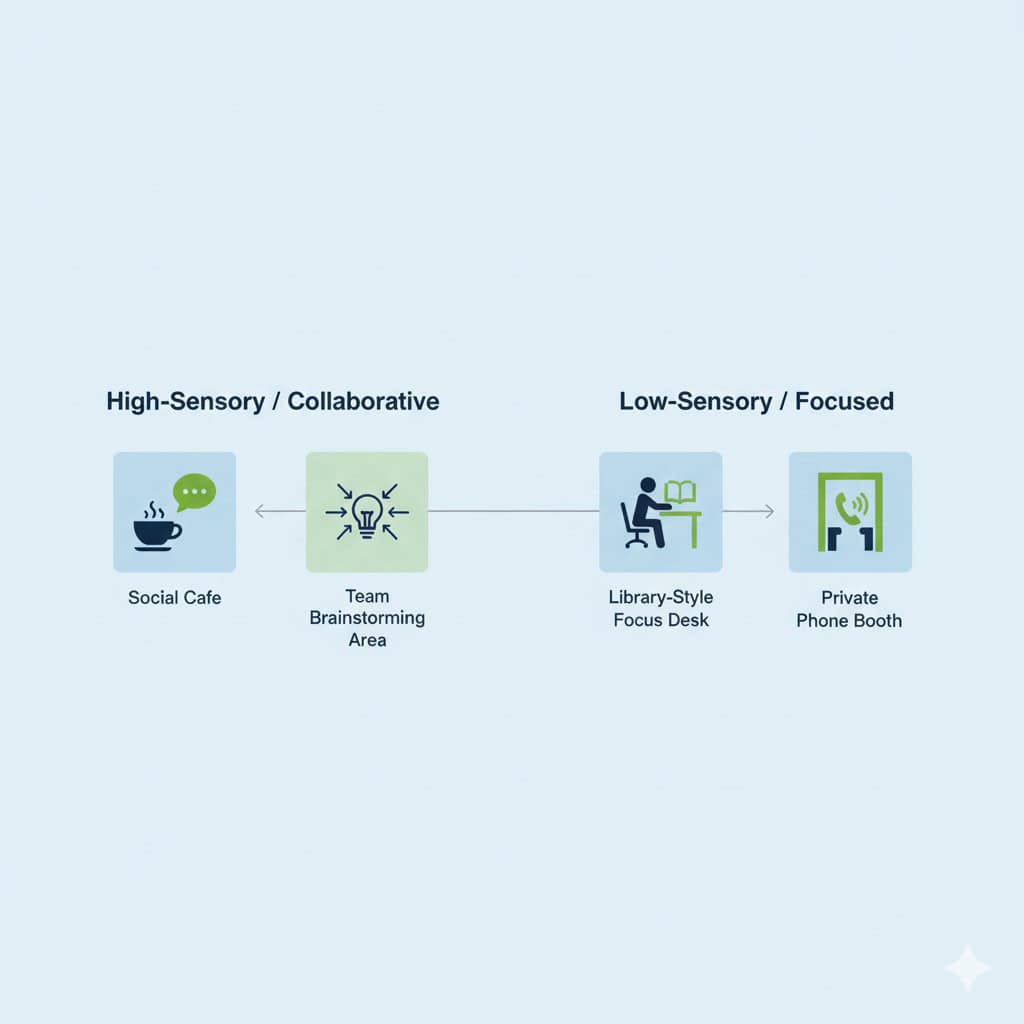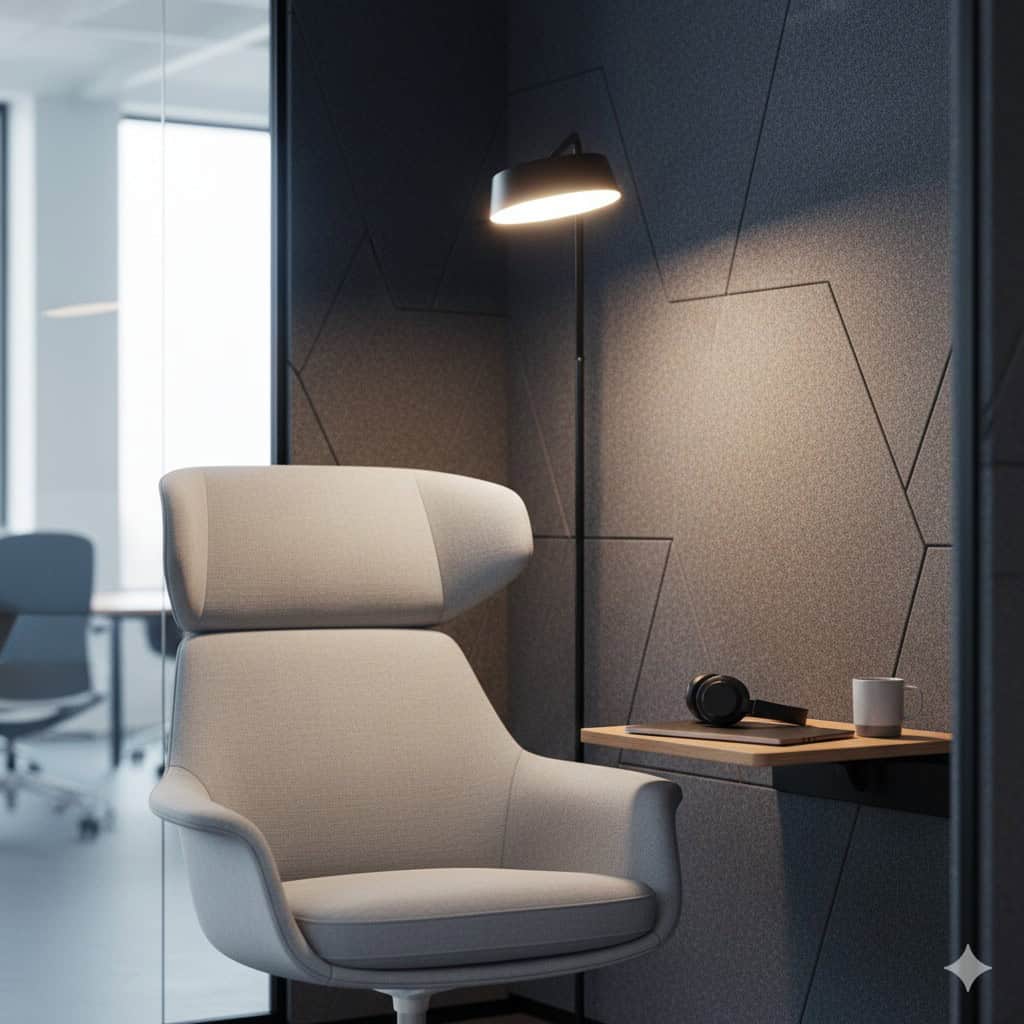Your One-Size-Fits-All Office Is Failing Your Team. It’s Time for Neuro-inclusive Design.
Imagine your company decides to cater lunch for everyone, every single day. The catch? The only thing on the menu is spicy chili. For those who love bold flavors, it’s a paradise. But what about everyone else? The person with a sensitive stomach, the one who prefers milder food, the vegetarian—they’re left hungry and unable to do their best.
This is exactly how we’ve been designing our offices for decades. We’ve offered a single “dish”—often a loud, bright, open-plan layout—and expected every employee to thrive.
The truth is, a “one-size-fits-all” office serves a mythical “ideal” employee. But our teams are made up of introverts, extroverts, deep thinkers, verbal processors, and people with a wide range of sensory sensitivities. To unlock the full potential of this diverse talent, we need to stop designing a single office and start creating a varied landscape. This is the core idea behind neuro-inclusive office design.
The Myth of the “Ideal” Employee
The modern open office was designed for constant collaboration and high energy. It’s a space that caters to the extroverted, externally-processing brain. But for many, it’s a productivity minefield. The constant hum of conversation, the visual distraction of people walking by, the lack of privacy—it’s a nightmare for the deep-thinking introvert or anyone who needs quiet to concentrate. Creating an effective office for introverts and other mind types isn’t about separation; it’s about providing options.
So, What Is Neuro-inclusive Design, Really?
Don’t let the term intimidate you. At its heart, designing for neurodiversity is simple. It’s about two things: Choice and Control.
It’s about creating an environment with a variety of spaces and empowering employees to choose the one that best suits their task and their mental state at that moment. Instead of a single dish, it’s a buffet. An employee isn’t just “at their desk”; they are moving through a landscape of zones designed for different kinds of work, acknowledging their unique workplace sensory needs.
Practical Steps to a More Inclusive Space (Without a Big Budget)
You don’t need a complete office overhaul to get started. Meaningful change can happen at both the macro (office) and micro (desk) levels.
For the Office: Create a Buffet of Zones
- The Library: Designate a specific area for quiet, focused work. Implement a “library rules” policy: no calls, no conversations. This is a sanctuary for heads-down tasks.
- The Town Hall: Your social hub. The kitchen or a lounge area with comfortable seating where spontaneous conversations are encouraged. This contains the social energy, preventing it from spilling into focus zones.
- The Collaboration Studio: An energetic zone with whiteboards, large screens, and flexible furniture designed for team brainstorming and lively discussion.
- The Private Booth: Install one or two single-person pods or convert small offices into private booths for confidential calls or when someone needs zero distractions.
For Your Desk: Empower Individual Control
- Headphones as a Boundary: Normalize the use of noise-canceling headphones as a universal “do not disturb” sign.
- Control the Light: Provide desk lamps so individuals can adjust the lighting in their immediate workspace. Some people focus better in bright light, others in dimmer conditions.
- Create Visual Barriers: Offer portable desk dividers or encourage the use of plants and monitors to create a sense of personal space and reduce visual clutter.
- Fidget-Friendly Tools: Recognize that some people think better when moving. Make stress balls, fidget spinners, or even under-desk cycling machines available and acceptable.
Beyond the Space: Fostering an Inclusive Culture
A truly neuro-inclusive workplace isn’t just about the furniture. The physical environment must be supported by the culture.
- Permission to Move: Actively encourage employees to move between different zones based on their needs, without judgment.
- Respect the Calendar: Foster a culture where “focus time” blocked on a calendar is treated as seriously as a meeting.
- Flexible Schedules: Acknowledge that people have different energy peaks. Allow for flexible start and end times where possible.
Creating a workplace that embraces every type of mind isn’t just a compassionate act—it’s a strategic advantage. It tells your team that you see them as individuals and are invested in giving them the tools they need to succeed. Stop serving just one dish and start building a buffet where everyone can thrive.
What type of space is most popular with your team? The quiet corner, the bustling cafe, or the collaborative zones? Share your insights in the comments below!






